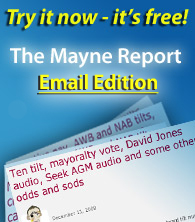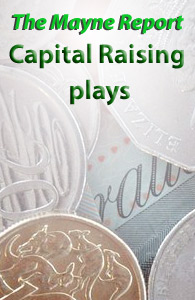Bank crisis, BHP dive, Macquarie conflicts, Phil Green loan, Rio rolls and playing the SPPs
January 22, 2009
Dear Mayne Reporters,
Sitting here in the early of hours of Thursday morning it is remarkable to reflect back over recent history, including the past 24 hours.
Exactly one year ago, I was sitting in the ABC commentary box at Melbourne Park during the Australian Open with 774 ABC Melbourne Drive presenter Lindy Burns discussing the dramatic 408 points slump in the All Ordinaries that day - January 22, 2007. Have a listen.
Whilst a 7.5% hit was big, in points terms it was the biggest single dive since the October 1987 sharemarket crash. But that 408 point retreat took the All Ords down to 5222 points. Over the past year, it has retreated another 35% to yesterday's close of 3394.8, which is only 2% above last November's 5 year lows.
Yesterday, I was back in that same ABC commentary box, this time to talk about the biggest ever wipe-out in US bank equity with Libby Gore. Have a listen.
Given Wall Street's 4% slump on Tuesday night, the Australian resilience that contained our losses to 1% was quite remarkable when you consider it was the worst news day yet for local job losses with CSR, TD Securities, David Jones and, the big one, BHP Billiton all announcing sackings.
However, this is once again a story about risk-taking global bankers and we remain incredibly lucky that our bank cartel largely kept out of the game, preferring the enormous returns from gouging Australian customers through the world's most expensive banking system.
We won't see another day quite like yesterday, especially when you consider how Australian banks now rank against the big nine US banks that were bailed out last October. The following table includes changes in market value since last Friday and Tuesday night's drop on Wall St, which coincided with President Obama's inauguration:
1. JP Morgan: $US90.85bn to $US67.5bn after 21% last night
2. Wells Fargo: $US83.85bn to $US59.2bn after 24% last night
3. Bank of America: $US53.19bn to $US32.6bn after 29% last night
4. Westpac: $43.3bn ($US28.5bn) - down 3.1% yesterday
5. Goldman Sachs: $US32.64bn to $US26.17bn after 19% last night
6. Commonwealth Bank: $37.7bn ($US24.8bn) - down 2.81% yesterday
7. National Australia Bank: $34.14 ($US22.43bn) - down 4.74% yesterday
8. Bank of New York Mellon Corp: $US26.73bn to $US21.8bn after 17% last night
9. ANZ: $28.67 ($US18.84bn) - down 3.87% yesterday
10. Citigroup: $US20.87 billion to $US15.26bn after 20% last night
11. Morgan Stanley: $US17.03bn to $US13.72bn after 16% last night
12. State Street: $US16.41bn to $US6.43bn after 59% last night
The US banks have recovered marginally in early trade today but who would ever have thought that little old Australia would have four banks that would rank in the top 9 when lined up against their giant American rivals, given the US economy is 30 times our size. It just goes to show how far the Masters of the Universe on Wall Street have fallen and how lucrative the Australian cartel has been, especially with many competitors now falling by the wayside.
Bendigo holding up best in the storm
Whilst our Big Four banks fell by 3-5% yesterday and hit a multi-year low of about $142 billion in capitalisation, even little Australian players like Bendigo and Adelaide Bank are still capitalised at $3 billion, making it more valuable than the likes of Lend Lease, Fairfax, Boral, Harvey Norman, Bluescope Steel, Onesteel, CSR, Goodman Fielder and James Hardie.
Bendigo shares actually rose 9c to $10.09 yesterday and it is now a top 50 company that is enjoying growing deposits and is tipped to deliver a record profit of more than $200 million this financial year because it won't have the big blowout in bad debts through exposures to the likes of Allco, Babock, ABC Learning and Centro.
Check out this recent presentation by Bendigo to see just how conservative it is with only 6 single exposures above $30 million, all of which are performing well.
In fact, Bendigo is also the only Australian bank that has held above its issue price from a recent capital raising, given that the $175 million raised from its loyal shareholder base on December 23 was priced at $10.
Westpac's big placement was at $16 and the stock finished at $15.02 yesterday and even CBA's botched and discounted $2 billion raising at $26 is under water with the stock finishing at $25.61 last night.
Could BHP-Billiton be headed for losses?
Whilst the global financial crisis is a major worry for Australia - especially the challenge of refinancing fleeing foreign banks who've lent much of our scarily large $1 trillion foreign debt - the bigger concern is the bursting of the resources bubble and what BHP-Billiton announced yesterday.
The loss of 6000 jobs - 3300 in Australia from the coal and nickel divisions - has grabbed all the headlines today, but an equally important issue is plunging tax revenues for state and federal governments.
Consider this growth in BHP-Billiton's net profit figures over the past six years:
2007-08: $US15.4bn net profit on revenue of $US59.57
06-07: $US13.4bn
05-06: $US10.45bn
04-05: $US6.43bn
03-04: $US3.38bn
02-03: $US1.92bn net profit on revenue of $US17 billion
That 2007-08 BHP Billiton net profit was worth $A24 billion at today's much weaker exchange rate, which equates to $66 million a day. Canberra would have pocketed close to $10 billion from The Big Australian last financial year, but now that BHP-Billiton has announced writedowns of $5.6 billion to be booked in the December half on its faltering nickel business, how much will that leave for profit? And taxes?
Could the 2008-09 profit be lower than the $US3.38 billion profit from 2003-04 if oil remains below $US40 a barrel and we really do get those 50% cuts in coal and iron-ore prices, on top of the plunging volumes?
Whatever the case, Canberra will be getting at least $5 billion less from BHP-Billiton in 2008-09 and then you've got the plunging income tax payments from all those workers losing their jobs in the mines.
If the 3300 Australian workers shed by BHP yesterday were all pocketing an average $100,000 each, that's $330 million in wages not to be paid and about $100 million in tax revenue that won't go to Canberra.
This story is repeated right across the country, so is it any wonder Kevin Rudd and Wayne Swan are hinting about really tough times and big deficits into the future.
Tracking the biggest discounts to book value
Our favourite issue at the moment is the big arm wrestle going on between auditors and boards about whether assets have been impaired, such that book values should be written down in the forthcoming reporting season next month.
As of last night, here are where the 6 members of the $3 billion discount club are sitting:
Wesfarmers, $8.6bn: After paying a ridiculous debt-funded $18 billion for Coles, the market capitalisation of this once great industrial conglomerate has plunged to only $11 billion. The Australian's John Durie is reporting today that Wesfarmers will unveil another $2.5 billion-plus capital raising priced at about $14 this morning. This will be accompanied by a new debt rollover deal, which should also include a massive impairment charge against the inflated book value of the Coles acquisition.
Westfield, $6 billion: with $45 billion in shopping centre assets and $16 billion in debt, Westfield claims it has net assets of $29 billion. Alas, the market is getting nervous about that big debt pile and the dreadful retail enviroment, such that Westfield's market capitalisation fell to $23 billion yesterday - the lowest level since the three way merger in 2003-04.
GPT, $5bn: only managed to come up with a loss of $68 million for the June half, which left its claimed net assets of $8.15 billion more than double its current market cap of $3.1 billion, even after the recent $1 billion-plus capital raising. Stand by for a huge loss next month, that will feature in the top 10 of all time Down Under.
Centro Properties Group, $4bn: shopping centre write-downs sent it to a staggering net loss of $2.055 billion for the full year after notching up a $1.11 billion in loss in the first half. However, it still claims to have $20.5 billion in assets supporting its $16.4 billion in debt, giving it net assets of $4.1 billion when the market cap is just $92 million.
Macquarie Infrastructure Group, $3.1bn: claims net assets of $6.68 billion when market cap is now down to $3.5 billion, even with $1 billion in cash on the books.
So far, Babcock & Brown is the only company to signal a $2 billion-plus write-down next month? When will some of the above players listed above join the club?
Was there Macquarie inside dealing on struggling property fund?
Another company trading at a huge discount to book value is Macquarie Office, which owns 43 office towers around the world and claims to be worth $3.1 billion.
Alas, the current market capitalisation of $750 million suggests that a very big write-down is coming, especially given the board is presently trying to complete a massively discounted $408 million one-for-one rights issue at 20c to pay down excessive debt.
On December 5, Macquarie Group released this substantial shareholder notice revealing that it had cut its stake in Macquarie Office from 207.7 million shares or 10.15%, to 186.5 million shares or 9.13%.
The stock hit 20c yesterday and Macquarie is committing to pump another $100 million into the company at 20c as the underwriter of a capital raising that was announced on December 12 following a trading halt on December 9, just 6 days after the last sales by Macquarie.
This looked like a prima facie case of insider trading, so the following email was dispatched to the Macquarie spinners:
I'm a unitholder in Macquarie Office who has applied for additional units in the raising but also have a journalistic inquiry for a Mayne Report story I'm doing. How could Macquarie be a net seller of 21.5 million MOF units between October 21 and December 3 at prices ranging between 27c and 68c when we suddenly got an emergency $100m placement at 20c and a one for one raising at 20c announced on December 12 after the stock went into a trading halt on December 9.
Also, I note the some of the heaviest selling was in early December. How did the Chinese walls work on this one and why was the trading window open at all? I would have thought there should be no trading by any Macquarie entity in the lead up to such a substantial announcement.
This reply came back yesterday from Macquarie spinner Kerrie Lavey:
Macquarie Group lodged a Notice of change of interests of substantial holder on 3 December indicating that it had reduced its interest from 10.16% to 9.13% representing a sale of 21.2m units between October 21 and 3 December. None of this trading relates to the Group's principal holding. It relates to trading of units held on behalf of external clients by Macquarie Investment Management Limited (Macquarie Funds Group) and trading by Macquarie Securities in the ordinary course of business. These trading decisions are independent and there are effective Chinese walls between each of these groups with the result that those who authorised this trading would not have been in possession of non-public information regarding MOF's capital raising or other future plans.
Okay, Chinese Walls and all that, it is still not a good look for any arm of Macquarie to be ditching stock shortly before a deeply discounted rights issue. Given that the Rudd Labor Government has done diddly squat about improving corporate governance rules, it would be too much to expect the corporate plod would even make a few casual inquiries about this one. Ironically, ASIC is the second largest tenant in MOF's signature asset, No1 Martin Place, which doubles as the Millionaire Factory's global head office. ASIC is well placed to drop by to inspect these Chinese walls.
Whatever the trading situation, let's hope Macquarie Office recovers because I've applied for an additional $10,000 worth of units at 20c. This was done when the stock was 25c and before they extended the rights issue for a week and marginally reduced Macquarie's underwriting commitment. It is really annoying when issuers change the rules and Macquarie should have better detailed the exact nature of the underwriting in the initial offer documents.
Meanwhile, check out the substantial shareholder notice filed by Japanese investment giant Mitsui Life on January 15. Whilst Mitsui had been buying Macquarie Office stock gradually at much higher prices last year, it took a whopping 120 million units at 20c in the placement late last year.
Simon Jones, the former Macquarie Office chairman clearly shares Mitsui's view based on this recent email exchange:
Hi Simon, I know you've resigned as chairman but am interested to know whether you've taken up your entitlement to the Macquarie Office 20c rights issue, or whether you've applied for additional shares.
The register is a public document so could always search it but would appreciate a direct reply if that's not too much to ask.
Regards, Stephen Mayne
Macquarie Office unitholder
Reply from Simon Jones
Stephen, taken up my rights and applied for extra units as it represents an attractive deal to me.
Regards
Simon Jones
Executive Director
Macquarie Real Estate Capital
Chasing down Phil Green's Babcock loan
Below is an interesting email exchange with Babcock & Brown spinner Kelly Hibbins on a loan exposure to former CEO Phil Green:
Hi Kelly, has Phil Green repaid the loans outstanding detailed in the 2007 annual report?
Regards, Stephen Mayne
Reply from Kelly Hibbins:
Hi Stephen it's actually not a loan directly to Phil or indeed to Michael Maxwell. The amount of $7.7 million is a loan to a company that Michael and Phil together own about 28% of (the amount disclosed in the accounts is the total loan to the company not their share). The company's assets are being reviewed and will ultimately be sold down as part of our asset sale program.
Okay, so what happens if the asset sales don't generate enough to repay the loan and why was Babcock making such loans in the first place?
Share trading update
We've slowed down the recent share sales as the market slides away, but did manage a quick $100 profit on the QBE Insurance share purchase plan, which was heavily scaled back. Check out the announcement, because there hasn't been an SPP scale back as big as this one before.
Also, check out all our latest trades here and have a look at some upcoming share purchase plan plays we are considering, along with past SPP plays here.
Updated Rich List plus some
Considering the tumultuous past 12 months in world markets, our expansive business lists have needed some urgent attention. Check out these three lists that we have amended in recent days:
The biggest share tanks in history
Top Australians in global business
The Mayne Report Rich List
Rio sees the light on AGM records?
Well done to Rio Tinto for seeing the light on AGM records. This email was sent off to three Rio operatives on Monday:
We had an exchange a year ago where I asked for records of past AGMs and was denied. So far, I've had co-operation from everyone on this front except Macquarie and Rio.
Keeping records of AGMs and making them available is a pretty basic function of shareholder accountability which I feel very strong about, as was clear from this Mayne Report edition after last year's AGM in Brisbane:
Once again, I'm asking that you provide audio or transcripts (preferably both) from the following if they are in your records:
2001: Rio AGM in Sydney
2006: Rio AGM in Melbourne
2007: Rio EGM on Alcan acquisition in Melbourne
If not, then I'll be running for your board this year and can you please advise the deadline for nominations and what your constitution requires to nominate.
This is the tiniest of concessions to ask for and trust it won't be a problem to accommodate to avoid the first contested board election in Rio's history.
Regards,
Stephen Mayne
Rio Tinto shareholder
Lo and behold, the transcripts from 2006 and 2008 arrived today, although there is no record available of 2001 which was full of ferals complaining about everything under the sun.
Will Seven see the light?
The same deal - transcripts or a board tilt - has been offered to the Seven Network, which is still being considered after this earlier reply from long-serving Seven spindoctor Simon Francis:
Good to hear from you. We're not combative. We're a humble media company that contrasts with all of our competitors (we're actually doing OK). There's no transcript available.
I know this aggrieves you that we don't spend hundreds of thousands of dollars to set up webcasts. I know Peter Cox would like us to put on a Hollywood style presentation. As you know, we've been there and done that.
Now, we'd rather just perform and pay a dividend. Nothing's changed in our company since last we addressed the shareholders. If something had changed we'd have told the ASX and our shareholders. We're very conservative here at Seven.
Surely a conservative PR strategy would be to hand over some simple transcripts or audio files rather than face a messy contested board election at the AGM. Kerry Stokes is said to be a very obstinate man and we'll see an interesting test of this as the AGM approaches.
That's all for this week.
Do ya best, Stephen Mayne
* If you're reading this without being a subscriber, why not sign up for a free trial or take up our special $99 subscription offer which lasts until June 30, 2009. Alternatively, if you've had enough, click here to unsubscribe from this email list.
Sitting here in the early of hours of Thursday morning it is remarkable to reflect back over recent history, including the past 24 hours.
Exactly one year ago, I was sitting in the ABC commentary box at Melbourne Park during the Australian Open with 774 ABC Melbourne Drive presenter Lindy Burns discussing the dramatic 408 points slump in the All Ordinaries that day - January 22, 2007. Have a listen.
Whilst a 7.5% hit was big, in points terms it was the biggest single dive since the October 1987 sharemarket crash. But that 408 point retreat took the All Ords down to 5222 points. Over the past year, it has retreated another 35% to yesterday's close of 3394.8, which is only 2% above last November's 5 year lows.
Yesterday, I was back in that same ABC commentary box, this time to talk about the biggest ever wipe-out in US bank equity with Libby Gore. Have a listen.
Given Wall Street's 4% slump on Tuesday night, the Australian resilience that contained our losses to 1% was quite remarkable when you consider it was the worst news day yet for local job losses with CSR, TD Securities, David Jones and, the big one, BHP Billiton all announcing sackings.
However, this is once again a story about risk-taking global bankers and we remain incredibly lucky that our bank cartel largely kept out of the game, preferring the enormous returns from gouging Australian customers through the world's most expensive banking system.
We won't see another day quite like yesterday, especially when you consider how Australian banks now rank against the big nine US banks that were bailed out last October. The following table includes changes in market value since last Friday and Tuesday night's drop on Wall St, which coincided with President Obama's inauguration:
1. JP Morgan: $US90.85bn to $US67.5bn after 21% last night
2. Wells Fargo: $US83.85bn to $US59.2bn after 24% last night
3. Bank of America: $US53.19bn to $US32.6bn after 29% last night
4. Westpac: $43.3bn ($US28.5bn) - down 3.1% yesterday
5. Goldman Sachs: $US32.64bn to $US26.17bn after 19% last night
6. Commonwealth Bank: $37.7bn ($US24.8bn) - down 2.81% yesterday
7. National Australia Bank: $34.14 ($US22.43bn) - down 4.74% yesterday
8. Bank of New York Mellon Corp: $US26.73bn to $US21.8bn after 17% last night
9. ANZ: $28.67 ($US18.84bn) - down 3.87% yesterday
10. Citigroup: $US20.87 billion to $US15.26bn after 20% last night
11. Morgan Stanley: $US17.03bn to $US13.72bn after 16% last night
12. State Street: $US16.41bn to $US6.43bn after 59% last night
The US banks have recovered marginally in early trade today but who would ever have thought that little old Australia would have four banks that would rank in the top 9 when lined up against their giant American rivals, given the US economy is 30 times our size. It just goes to show how far the Masters of the Universe on Wall Street have fallen and how lucrative the Australian cartel has been, especially with many competitors now falling by the wayside.
Bendigo holding up best in the storm
Whilst our Big Four banks fell by 3-5% yesterday and hit a multi-year low of about $142 billion in capitalisation, even little Australian players like Bendigo and Adelaide Bank are still capitalised at $3 billion, making it more valuable than the likes of Lend Lease, Fairfax, Boral, Harvey Norman, Bluescope Steel, Onesteel, CSR, Goodman Fielder and James Hardie.
Bendigo shares actually rose 9c to $10.09 yesterday and it is now a top 50 company that is enjoying growing deposits and is tipped to deliver a record profit of more than $200 million this financial year because it won't have the big blowout in bad debts through exposures to the likes of Allco, Babock, ABC Learning and Centro.
Check out this recent presentation by Bendigo to see just how conservative it is with only 6 single exposures above $30 million, all of which are performing well.
In fact, Bendigo is also the only Australian bank that has held above its issue price from a recent capital raising, given that the $175 million raised from its loyal shareholder base on December 23 was priced at $10.
Westpac's big placement was at $16 and the stock finished at $15.02 yesterday and even CBA's botched and discounted $2 billion raising at $26 is under water with the stock finishing at $25.61 last night.
Could BHP-Billiton be headed for losses?
Whilst the global financial crisis is a major worry for Australia - especially the challenge of refinancing fleeing foreign banks who've lent much of our scarily large $1 trillion foreign debt - the bigger concern is the bursting of the resources bubble and what BHP-Billiton announced yesterday.
The loss of 6000 jobs - 3300 in Australia from the coal and nickel divisions - has grabbed all the headlines today, but an equally important issue is plunging tax revenues for state and federal governments.
Consider this growth in BHP-Billiton's net profit figures over the past six years:
2007-08: $US15.4bn net profit on revenue of $US59.57
06-07: $US13.4bn
05-06: $US10.45bn
04-05: $US6.43bn
03-04: $US3.38bn
02-03: $US1.92bn net profit on revenue of $US17 billion
That 2007-08 BHP Billiton net profit was worth $A24 billion at today's much weaker exchange rate, which equates to $66 million a day. Canberra would have pocketed close to $10 billion from The Big Australian last financial year, but now that BHP-Billiton has announced writedowns of $5.6 billion to be booked in the December half on its faltering nickel business, how much will that leave for profit? And taxes?
Could the 2008-09 profit be lower than the $US3.38 billion profit from 2003-04 if oil remains below $US40 a barrel and we really do get those 50% cuts in coal and iron-ore prices, on top of the plunging volumes?
Whatever the case, Canberra will be getting at least $5 billion less from BHP-Billiton in 2008-09 and then you've got the plunging income tax payments from all those workers losing their jobs in the mines.
If the 3300 Australian workers shed by BHP yesterday were all pocketing an average $100,000 each, that's $330 million in wages not to be paid and about $100 million in tax revenue that won't go to Canberra.
This story is repeated right across the country, so is it any wonder Kevin Rudd and Wayne Swan are hinting about really tough times and big deficits into the future.
Tracking the biggest discounts to book value
Our favourite issue at the moment is the big arm wrestle going on between auditors and boards about whether assets have been impaired, such that book values should be written down in the forthcoming reporting season next month.
As of last night, here are where the 6 members of the $3 billion discount club are sitting:
Wesfarmers, $8.6bn: After paying a ridiculous debt-funded $18 billion for Coles, the market capitalisation of this once great industrial conglomerate has plunged to only $11 billion. The Australian's John Durie is reporting today that Wesfarmers will unveil another $2.5 billion-plus capital raising priced at about $14 this morning. This will be accompanied by a new debt rollover deal, which should also include a massive impairment charge against the inflated book value of the Coles acquisition.
Westfield, $6 billion: with $45 billion in shopping centre assets and $16 billion in debt, Westfield claims it has net assets of $29 billion. Alas, the market is getting nervous about that big debt pile and the dreadful retail enviroment, such that Westfield's market capitalisation fell to $23 billion yesterday - the lowest level since the three way merger in 2003-04.
GPT, $5bn: only managed to come up with a loss of $68 million for the June half, which left its claimed net assets of $8.15 billion more than double its current market cap of $3.1 billion, even after the recent $1 billion-plus capital raising. Stand by for a huge loss next month, that will feature in the top 10 of all time Down Under.
Centro Properties Group, $4bn: shopping centre write-downs sent it to a staggering net loss of $2.055 billion for the full year after notching up a $1.11 billion in loss in the first half. However, it still claims to have $20.5 billion in assets supporting its $16.4 billion in debt, giving it net assets of $4.1 billion when the market cap is just $92 million.
Macquarie Infrastructure Group, $3.1bn: claims net assets of $6.68 billion when market cap is now down to $3.5 billion, even with $1 billion in cash on the books.
So far, Babcock & Brown is the only company to signal a $2 billion-plus write-down next month? When will some of the above players listed above join the club?
Was there Macquarie inside dealing on struggling property fund?
Another company trading at a huge discount to book value is Macquarie Office, which owns 43 office towers around the world and claims to be worth $3.1 billion.
Alas, the current market capitalisation of $750 million suggests that a very big write-down is coming, especially given the board is presently trying to complete a massively discounted $408 million one-for-one rights issue at 20c to pay down excessive debt.
On December 5, Macquarie Group released this substantial shareholder notice revealing that it had cut its stake in Macquarie Office from 207.7 million shares or 10.15%, to 186.5 million shares or 9.13%.
The stock hit 20c yesterday and Macquarie is committing to pump another $100 million into the company at 20c as the underwriter of a capital raising that was announced on December 12 following a trading halt on December 9, just 6 days after the last sales by Macquarie.
This looked like a prima facie case of insider trading, so the following email was dispatched to the Macquarie spinners:
I'm a unitholder in Macquarie Office who has applied for additional units in the raising but also have a journalistic inquiry for a Mayne Report story I'm doing. How could Macquarie be a net seller of 21.5 million MOF units between October 21 and December 3 at prices ranging between 27c and 68c when we suddenly got an emergency $100m placement at 20c and a one for one raising at 20c announced on December 12 after the stock went into a trading halt on December 9.
Also, I note the some of the heaviest selling was in early December. How did the Chinese walls work on this one and why was the trading window open at all? I would have thought there should be no trading by any Macquarie entity in the lead up to such a substantial announcement.
This reply came back yesterday from Macquarie spinner Kerrie Lavey:
Macquarie Group lodged a Notice of change of interests of substantial holder on 3 December indicating that it had reduced its interest from 10.16% to 9.13% representing a sale of 21.2m units between October 21 and 3 December. None of this trading relates to the Group's principal holding. It relates to trading of units held on behalf of external clients by Macquarie Investment Management Limited (Macquarie Funds Group) and trading by Macquarie Securities in the ordinary course of business. These trading decisions are independent and there are effective Chinese walls between each of these groups with the result that those who authorised this trading would not have been in possession of non-public information regarding MOF's capital raising or other future plans.
Okay, Chinese Walls and all that, it is still not a good look for any arm of Macquarie to be ditching stock shortly before a deeply discounted rights issue. Given that the Rudd Labor Government has done diddly squat about improving corporate governance rules, it would be too much to expect the corporate plod would even make a few casual inquiries about this one. Ironically, ASIC is the second largest tenant in MOF's signature asset, No1 Martin Place, which doubles as the Millionaire Factory's global head office. ASIC is well placed to drop by to inspect these Chinese walls.
Whatever the trading situation, let's hope Macquarie Office recovers because I've applied for an additional $10,000 worth of units at 20c. This was done when the stock was 25c and before they extended the rights issue for a week and marginally reduced Macquarie's underwriting commitment. It is really annoying when issuers change the rules and Macquarie should have better detailed the exact nature of the underwriting in the initial offer documents.
Meanwhile, check out the substantial shareholder notice filed by Japanese investment giant Mitsui Life on January 15. Whilst Mitsui had been buying Macquarie Office stock gradually at much higher prices last year, it took a whopping 120 million units at 20c in the placement late last year.
Simon Jones, the former Macquarie Office chairman clearly shares Mitsui's view based on this recent email exchange:
Hi Simon, I know you've resigned as chairman but am interested to know whether you've taken up your entitlement to the Macquarie Office 20c rights issue, or whether you've applied for additional shares.
The register is a public document so could always search it but would appreciate a direct reply if that's not too much to ask.
Regards, Stephen Mayne
Macquarie Office unitholder
Reply from Simon Jones
Stephen, taken up my rights and applied for extra units as it represents an attractive deal to me.
Regards
Simon Jones
Executive Director
Macquarie Real Estate Capital
Chasing down Phil Green's Babcock loan
Below is an interesting email exchange with Babcock & Brown spinner Kelly Hibbins on a loan exposure to former CEO Phil Green:
Hi Kelly, has Phil Green repaid the loans outstanding detailed in the 2007 annual report?
Regards, Stephen Mayne
Reply from Kelly Hibbins:
Hi Stephen it's actually not a loan directly to Phil or indeed to Michael Maxwell. The amount of $7.7 million is a loan to a company that Michael and Phil together own about 28% of (the amount disclosed in the accounts is the total loan to the company not their share). The company's assets are being reviewed and will ultimately be sold down as part of our asset sale program.
Okay, so what happens if the asset sales don't generate enough to repay the loan and why was Babcock making such loans in the first place?
Share trading update
We've slowed down the recent share sales as the market slides away, but did manage a quick $100 profit on the QBE Insurance share purchase plan, which was heavily scaled back. Check out the announcement, because there hasn't been an SPP scale back as big as this one before.
Also, check out all our latest trades here and have a look at some upcoming share purchase plan plays we are considering, along with past SPP plays here.
Updated Rich List plus some
Considering the tumultuous past 12 months in world markets, our expansive business lists have needed some urgent attention. Check out these three lists that we have amended in recent days:
The biggest share tanks in history
Top Australians in global business
The Mayne Report Rich List
Rio sees the light on AGM records?
Well done to Rio Tinto for seeing the light on AGM records. This email was sent off to three Rio operatives on Monday:
We had an exchange a year ago where I asked for records of past AGMs and was denied. So far, I've had co-operation from everyone on this front except Macquarie and Rio.
Keeping records of AGMs and making them available is a pretty basic function of shareholder accountability which I feel very strong about, as was clear from this Mayne Report edition after last year's AGM in Brisbane:
Once again, I'm asking that you provide audio or transcripts (preferably both) from the following if they are in your records:
2001: Rio AGM in Sydney
2006: Rio AGM in Melbourne
2007: Rio EGM on Alcan acquisition in Melbourne
If not, then I'll be running for your board this year and can you please advise the deadline for nominations and what your constitution requires to nominate.
This is the tiniest of concessions to ask for and trust it won't be a problem to accommodate to avoid the first contested board election in Rio's history.
Regards,
Stephen Mayne
Rio Tinto shareholder
Lo and behold, the transcripts from 2006 and 2008 arrived today, although there is no record available of 2001 which was full of ferals complaining about everything under the sun.
Will Seven see the light?
The same deal - transcripts or a board tilt - has been offered to the Seven Network, which is still being considered after this earlier reply from long-serving Seven spindoctor Simon Francis:
Good to hear from you. We're not combative. We're a humble media company that contrasts with all of our competitors (we're actually doing OK). There's no transcript available.
I know this aggrieves you that we don't spend hundreds of thousands of dollars to set up webcasts. I know Peter Cox would like us to put on a Hollywood style presentation. As you know, we've been there and done that.
Now, we'd rather just perform and pay a dividend. Nothing's changed in our company since last we addressed the shareholders. If something had changed we'd have told the ASX and our shareholders. We're very conservative here at Seven.
Surely a conservative PR strategy would be to hand over some simple transcripts or audio files rather than face a messy contested board election at the AGM. Kerry Stokes is said to be a very obstinate man and we'll see an interesting test of this as the AGM approaches.
That's all for this week.
Do ya best, Stephen Mayne
* If you're reading this without being a subscriber, why not sign up for a free trial or take up our special $99 subscription offer which lasts until June 30, 2009. Alternatively, if you've had enough, click here to unsubscribe from this email list.





















